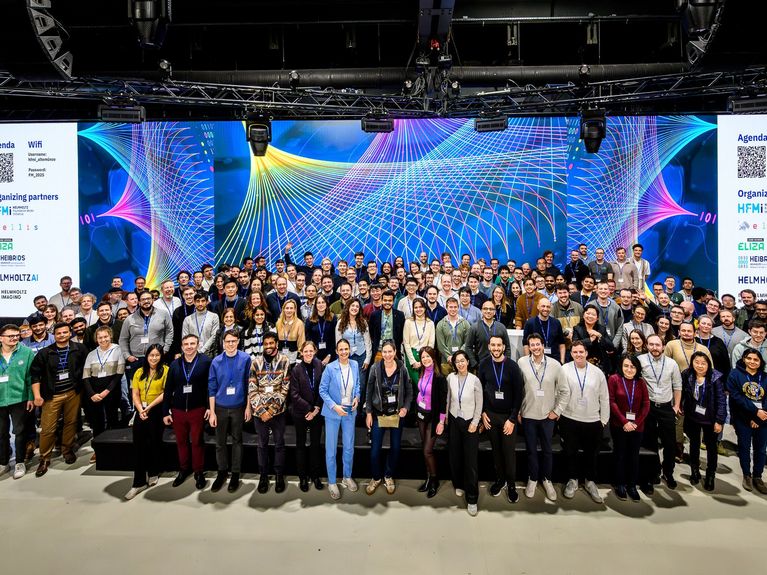Helmholtz-ELLIS Workshop
Trends in AI Research

Picture: Svea Pietschmann / Max Delbrück Center
What role should AI play in science, business, and society? How can we develop reliable AI models that also meet ethical standards? And how can we make models more effective while using resources as efficiently as possible?
These and many other questions were addressed during a two-day workshop held on March 18 and 19, jointly organized by Helmholtz and the European Laboratory for Learning and Intelligent Systems (ELLIS) in Berlin. Featuring top-tier speakers from Meta, Microsoft, ETH Zurich, the Simons Foundation, ELLIS, Helmholtz, and many other renowned partners, the workshop made a strong statement for interdisciplinary AI research.
The first day provided insights into the latest advancements in the development of Large Language Models (LLMs). On the second day, the focus shifted to how Artificial Intelligence has already become an indispensable tool for analyzing and solving complex scientific problems. From the Helmholtz Association, Lena Maier-Hein (DKFZ/Helmholtz Imaging) participated as a speaker. As an expert in machine learning for biomedical image analysis, she highlighted key gaps in the transparent evaluation of foundation models. Her goal: to spark a critical discussion on how future AI systems can be designed to be not only more useful, but also more reliable, transparent, and inclusive.
Picture: Svea Pietschmann / Max Delbrück Center
The workshop impressively demonstrated that the applications of foundation models are as diverse as science itself – and at the same time, that different disciplines face very similar methodological challenges when working with them. This was exemplified by the following talks: Shirley Ho (Simons Foundation & NYU) showcased how she successfully applies modern deep learning methods in astrophysics. She explained how AI-based approaches help analyze complex astrophysical datasets and gain new insights. Willie Neiswanger (USC) presented a foundation model trained on DNA and RNA sequences from wastewater samples. The model aims to comprehensively capture the full distribution of genomic information present across the human microbiome. His work highlights the potential of foundation models to develop an effective early warning system for emerging pathogens and potential pandemics. Sarath Chandar (MILA & Polytechnique Montréal) discussed the specific challenges of using foundation models in biological research. Through three examples, he illustrated that it is not the size of a model but rather data quality, effective representations, and task-specific evaluations that determine scientific success. Especially when simulating protein interactions and generating new molecules, a well-thought-out modeling concept is essential, he emphasized.
The talks made it clear: foundation models are becoming an interdisciplinary key tool – with the potential to unlock new insights where disciplinary boundaries previously limited collaboration. The workshop was organized by the Synergy Unit of the Helmholtz Foundation Model Initiative (HFMI), with the aim of connecting researchers from various scientific disciplines with AI experts. Because only through close collaboration between researchers from industry and academia can we tackle the complex scientific questions that today’s generation of AI models still struggle to answer.
Picture: Svea Pietschmann / Max Delbrück Center
“The pace at which LLMs and foundation models are developing is enormous,” says Florian Grötsch, manager of the "Information and Data Science" framework at the Helmholtz Association. “This makes it all the more important to not only strengthen regular exchange between method developers and users but also to establish shared benchmarks and advocate for openness in models.” He further explained that with the Synergy Unit, the Helmholtz Association has brought together a group of top researchers capable of facilitating and moderating this kind of exchange. In addition to promoting international knowledge exchange among leading AI players through workshops and conferences, the unit also addresses methodological questions in the development of foundation models, with a special focus on cost efficiency, performance, and cross-domain scalability.
Helmholtz President Otmar D. Wiestler also took part in the workshop. In his speech at the evening reception on the first day, held at the Museum of Natural History in Berlin, he emphasized: “With our world-leading HPC infrastructure, our Information and Data Science Framework, and the Helmholtz Foundation Model Initiative, we have laid the foundation for ambitious, AI-driven research, broken down silos, and fostering a cultural shift toward data-driven science across all research areas. However, no institution or country can succeed alone. Progress in this field moves at an incredible pace, and strong, reliable partnerships as well as close cooperation between all relevant stakeholders are essential. This joint workshop between Helmholtz and ELLIS is a wonderful example of the great power of scientific collaboration.”
Readers comments